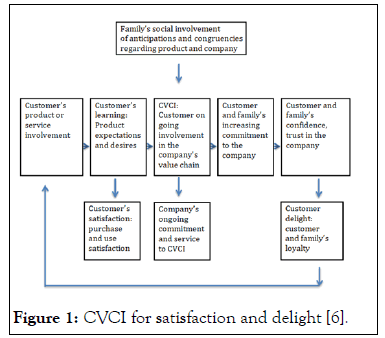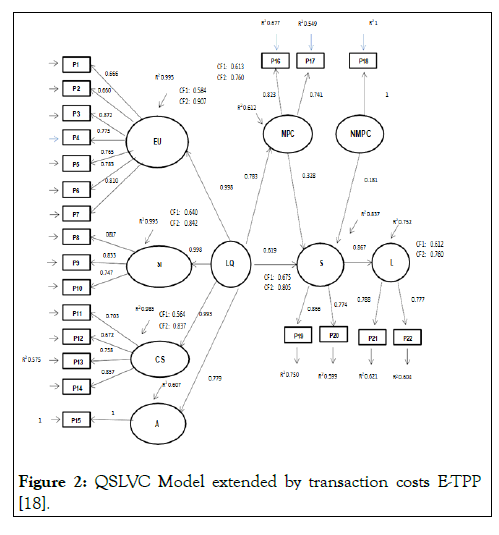Journal of Tourism & Hospitality
Open Access
ISSN: 2167-0269
ISSN: 2167-0269
Mini Review - (2021)Volume 10, Issue 6
The "perceived quality-customer satisfaction-customer loyalty" value chain is a critical framework to evaluate the performance of a customer-centric company. In E-tourism, the booking process is the first bilateral communication with the tourism service before the final experience. Although specialized literature provides exciting information about the behaviour of the three essential variables, it is crucial to understand the role of their components and consider other variables with the potential to enter into the model and influencing the process. From a critical view, and considering previous research, this work presents the key points regarding this idea and concludes that every particular research context could need specific methods. Hence, researchers and practitioners will benefit from questioning the entire value chain model and reviewing the measurement scales of the involved variables. That is an effective way to increase knowledge and improve decision-making.
E-Tourism; Online booking purchases; Quality-satisfaction-loyalty value chain; Decision-making
Since Porter defined the Value Chain (VC) [1], the term has evolved, mainly depending on the knowledge area. This contribution regards the supply chain of every organization as a concept from business management, narrowly linked to value creation.
A superior value arises through lower costs or superior benefits for customers. On the one hand, the value chain concept has been modeled as a knowledge management framework, considering infrastructure, processes, and interactions.
The result relates to knowledge performance because knowledge management organizes the knowledge value chain [2]. It means to accept that the value results from the difference between the utility combinations of benefits delivered to the customer and the total costs of acquiring them. Value is then a preferred combination of benefits (value criteria) compared with acquisition costs [3].
The concept of value is multifaceted, and there is a risk that the concept is used without any efforts to understand what it means to provide value to customers [4]. Therefore, the added value should be related to customer needs and benefits for the parties involved. The company must deliver to its demand a superior value from its VC, and it has to accomplish its requirements.
Thus, the customer is the core. Using a customer-centric approach, Slywotzky proposed a VC where the customer is the first link to all that follows [5].
Settling this idea, Mascarenhas, et al. provide a model of customer-value-chain involvement to enhance customer relationship management in conjunction with supply chain management [6].
The model represents a challenging approach to centering the organization on creating and maintaining customers. Hence, creating a real competitive advantage. In the same line, these contributions and others enriched the knowledge about the VC, unveiling the essential role of the marketing point of view analysing VC (see Figure 1).

Figure 1: CVCI for satisfaction and delight [6].
Transferring Porter's VC model to the marketing point of view is represented by the "perceived Quality-customer Satisfactioncustomer Loyalty" value chain (QSL). The QSLVC framework includes three essential marketing variables related to a causeeffect chain. Quality is the first level of output that a company (online tourism agents, including suppliers, searchers, metasearchers and online travel agencies) presents to the market. It is perceived quality, not objective because the customer provides its measurement. For the company, this output level is its first contact with the potential demand. The firm has launched its transformation process, and it is prepared to open doors to the potential demand. Even without a purchase experience, people can give an opinion by comparing with a reference according to their own past experiences, collected information, and an ideal offer. That is the first market test. The second level of output is customer satisfaction. Hence, it measures the difference between expectations and perceptions of the purchase experiences. The company needs to convert perceived quality into satisfaction because it has reached its target public. A better-perceived quality gets to higher levels of satisfaction.
Nevertheless, the company's survival depends on the consecution of loyalty, the third level of output. Loyalty provides the maintenance of the company in the market. Hence, it is crucial in the basic model. As shown in prior literature, a better level of satisfaction gets to higher levels of loyalty [7]. While quality is a variable linked to a global test to the market, satisfaction directly relates with customer acquisition, one of the two global marketing strategies, the offensive one, and loyalty regards customer retention, the defensive strategy. Perceived quality is the most extensively researched by itself [8], but not so much as an antecedent of satisfaction, and rarely of loyalty [9,10]. Ali recognizes the importance of investigating the complete sequence website Quality-Satisfaction-Loyalty and provides a model that confirms this structure of relationships for the hotel context [11].
All these variables need appropriate measurement models, and the primary model needs to consider other potentially essential variables. Every research context could need a different comprehensive model. Therefore, the question is whether the QSLVC can offer changes depending on the review context. Possible different measurement models of the primary variables and the influence of other variables not included in the primary model can play an important role.
The essential variables to evaluate the e-booking process performance
The traditional tourism service distribution is an integrated search-purchase-consumption process nowadays. The e-tourism booking process, crucial for the CV in online tourism channels, deserves attention in this sense. Several contributions have provided some light to the knowledge. Nevertheless, understanding the e-booking purchase process needs more conscientious review, deepening the new factors in play. In particular, the knowledge advance needs to adapt the particular conditions of the review context and identify all the involved variables in a comprehensive model.
The perceived quality of the e-booking purchase process focuses mainly on the website (app or other media) that the purchaser uses. It must be measured both regarding the product's attributes and the global perceived level. When it deals with customers who purchase through the website of a touristic provider or an intermediary, the user evaluates the website quality through different attributes [12]. Vazquez- Casielles, et al. studied e-service quality dimensions for virtual agencies [13]. They provide a framework of QSLVC and show how e-service quality influences customer satisfaction. Loyalty is the last stage, but the relationship is not analyzed. While quality is a multidimensional variable, there is not a unanimously accepted scale version but the different contributions, including adapted measurement scales. It could be the right way because it is essential to review the role of the variable in new scenarios and its measurement scales. Thus, the development of online tourism might require a re- identification of the variable components bearing in mind its utilitarian (usability, functionality, security) and hedonic (pleasantness, fun, sociability, perceived flow) aspects [14]. The second milestone, customer’s satisfaction, deals with an evaluation of the (dis) confirmation of expectations inherent in a product acquisition/ consumption experience [15]. It implies the necessary presence of a goal that the consumer wants to achieve [16]. Enhancing customer satisfaction has become an essential issue faced by online tourism [17].
Customer loyalty can be attitudinal (intentional variable) and behavioral. Truly loyalty is the last because it regards the repurchase of an exact customer and means the success of the business strategy, the utility of its competitive advantage, level of differentiation, and positioning.
Even though the VC brings the three essential variables, most of the works deal with the first two. Ali are the only works founded where satisfaction acts as a cause of loyalty [11,14,16]. However, the loyalty variable deals with attitudinal, intentional, and not behavioural. Hence, it is just an approach to the actual value chain sequence. The proper final step should be loyalty measured by repurchase. Berne-Manero, et al. offer an extension of the QSLVC model to understand better the primary variables composition of the value chain and the role of the transaction costs (electronic tourism purchasing, e-TPP, model). The transaction costs represent the customer’s participation in the co-production of the online tourism service. Perceived quality is a multidimensional variable with a measurement scale composed of utilitarian and hedonic attributes regarding easy-ofuse, service information, customer service and visual attraction. Authors find that, from the digital consumer perspective, the transaction costs influence the relationships between the fundamental variables of the QSLVC basic model. Perceived quality and transaction costs determine customer’s satisfaction and, ultimately, repurchase intentions or brand loyalty (intentional loyalty). Prices emerge as mediator variables fostering quality on satisfaction, and non-monetary costs act as a cause of satisfaction. Authors conclude that e-tourism channels must implement efficient internal and external processes to justify perceived costs.
More recently, the work of Wang reveals the importance to adapt the basic QSLVC depending on the review context. Despite it does not study the loyalty variable [17]. The review decomposes the VC of Online Travel Agencies (OTA) and proposes an OTA customer satisfaction measurement scale for a particular tourism platform in the China industry. The scale has five levels with secondary indicators related to the service quality measurement model. According to the results, the service quality of OTA and customer satisfaction could improve by applying the evaluation method that the authors propose.
To complement the discussion, Figures 1 and 2 present the analytical frameworks of [6,18]. Figure 1 represents a customercentric value chain; a circuit that comes out of customer’s involvement gets customer loyalty, influencing customer involvement. Figure 2 reveals the utility of considering monetary and non-monetary transaction costs, adapted dimensions of perceived utilitarian and hedonic quality, and short-term and long-term satisfaction levels.

Figure 2: QSLVC Model extended by transaction costs E-TPP [18].
Several conclusions and research/practitioners' implications arise from this paper. First of all, the primary shorter VC from the marketing perspective is a basis for analysing the performance of any company. In this sense, the emergence of online channels in tourism distribution deserves attention as a new context of market operations and a new way to understand the entire tourism sector. The acceptance of the short sequence of the VC is not enough. Every research plan must bear in mind the particular conditions of the study context to obtain effective making decisions. Second and intimately related, the customercentric is the correct orientation. Consumers are essential as coproducers in the e-tourism purchase processes, and companies need to ensure a suitable interaction with them and adapt the service's characteristics as much as possible. This task covers the whole process from the first electronic contact (website quality) to the purchase decision (website quality and satisfaction) and the effects on customer retention to the brand (loyalty). Further, co-production in online tourism booking purchase goes to cocreation, aimed to create innovations, which could be essential to satisfy and build loyalty based on service personalization. Third, the different nuances offered by the existing research warn about the convenience of treating each research context not only considering the primary QSLVC but also identifying all the variables that can influence this model and extend it, and reviewing their measures and potential role in the set.
We acknowledge the support for this review from the CREVALOR Research Group and the PID2019-108554RB-I00 Research Project.
Citation: Berne-Manero C. The Quality-Satisfaction-Loyalty Value Chain in the Online Tourism Booking Purchase Processes. J Tourism Hospit.10: 483.
Received: 15-Dec-2021 Accepted: 29-Dec-2021 Published: 05-Jan-2022
Copyright: © 2021 Berne-Manero C. This is an open-access article distributed under the terms of the Creative Commons Attribution License, which permits unrestricted use, distribution, and reproduction in any medium, provided the original author and source are credited.